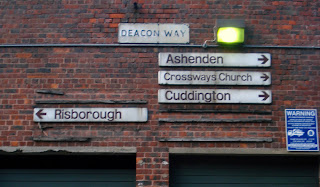10 Sept 2011
boundless (London, 2011)
The practice's focus is placed on analysing our perceptions of housing estates, with a ground basis of being in a boundless journey: an unconfined exploration unrestricted to standards and pre-established values. The notoriously infamous council estate in South London, the Heygate Estate, is currently emptied and due for demolition and became the location where my journeys took place. These were recorded using film and photography and also revealed as light trails, a metaphorical depiction of my own explorations and presence in the barren site, where once thousands lived and called it home. Boundaries can be physical, imaginary, and representational, like the Prime Meridian line that divides the world in half, and makes one wonder whether in fact it actually represents anything. At times, boundaries can have an implicit quality, like the separation of public and private in certain un-gated properties. All these boundaries delineate the city and its citizens and how one perceives the other. Bearing in mind the notion of navigating the borderlines, how can this be expressed and experienced in art form? The answer comes from this experimentation using film and photography in a journey of discovery and questions.
28 Aug 2011
24 Aug 2011
8 Aug 2011
6 Aug 2011
recording movement
12 Jul 2011
12 Jun 2011
21 May 2011
assessment exhibition
Boundless: the city through the eyes of the wanderer
To explore the city and its dwellings is to question how the latter is seen, as well as treated by the city dwellers. I have a personal will to show the hidden beauties, untold stories and overlooked details within these housing estates. However how can this be expressed and experienced? The answer comes from this project using film and photography of a journey through the city in the eyes of the wanderer (ie. the flâneur). The journey is composed of a series of walks done during the daytime and night time in sites/locations that reflect the city and its dwellings. Video and photographic documentation of the actions have been done to record the experimentation. Firstly, I set myself the role of the director and of the wanderer (personified by the figure in the documentation). Then I identified similarities and differences in the condition which an area is found, what I called the ‘state of the city’. The observations from the identification process led to categorise the states of the city into three groups: ruination, appropriation, transformation. These are represented as colour-coded tags. The action of tagging these states was also documented.
16 May 2011
7 May 2011
6 May 2011
Pinheiros
Video documentation of an action
in a hybrid state of ruination, appropriation and transformation
10 Apr 2011
4 Apr 2011
18 Mar 2011
8 Mar 2011
Page's Walk
Video documentation of an action
in a state of appropriation
21 Feb 2011
30 Jan 2011
19 Jan 2011
british land:
This project aims to question the boundaries between the private and public spaces by means of a night intervention and with the use of lights as a way to draw people in. When analysing the Regent’s Place estate, I found that even in late hours there are always pedestrians on the sidewalks along the site and many people waiting at the bus stops. In spite of that, the site itself seems always to be rather empty and as there is no real separation between the public and private spaces, I began to wonder if that trend could not be reversed. During the day, the situation is quite the opposite. There are people walking to and from work, to the gym and there are even those that use the estate as a shortcut to cross to the other side. Some of its features, like some of the artworks and the landscaping, offer at times a barrier rather than an entry. To counteract this predicament, I am proposing an intervention that can be seen during the day, but that only fully blossoms during the night. The intent of the proposal is to devise a sculptural and/or a performance-based installation that aspires to be a celebration of the pedestrians and passers-by.
















































